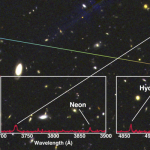W. M. Keck Observatory press release…
An International team led by scientists at ETH Zurich in Switzerland used the W. M. Keck Observatory to study the role of star formation rates in metal contents of distant galaxies. What they discovered is the amount of metals are very similar, irrespective of galaxies’ star formation activity, raising new questions about star-forming theory. Their findings were recently published in the Astrophysical Journal.

The team found typical galaxies forming stars in the Universe two billion years after the Big Bang have only twenty percent of metals (elements heavier than Helium) compared with those in the present day Universe. They also discovered the metal content is independent of the strength of the star-formation activity – in stark contrast with what is known for recently formed, or nearby galaxies.
Continue reading “Metal Content in Early Galaxies Challenges Star Forming Theory”
